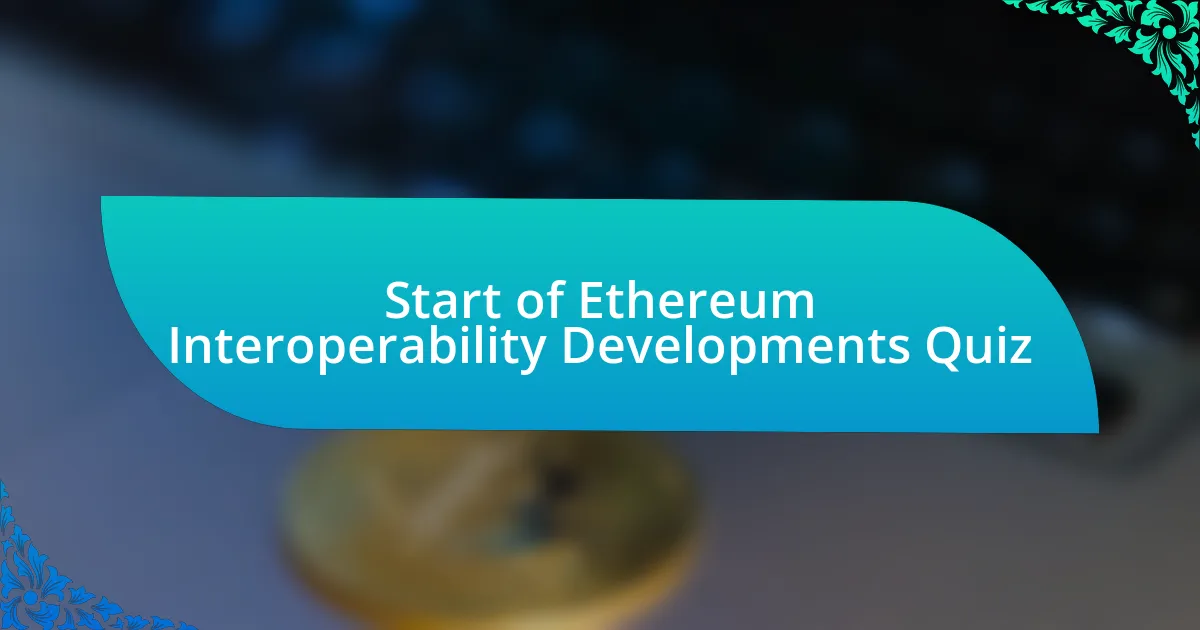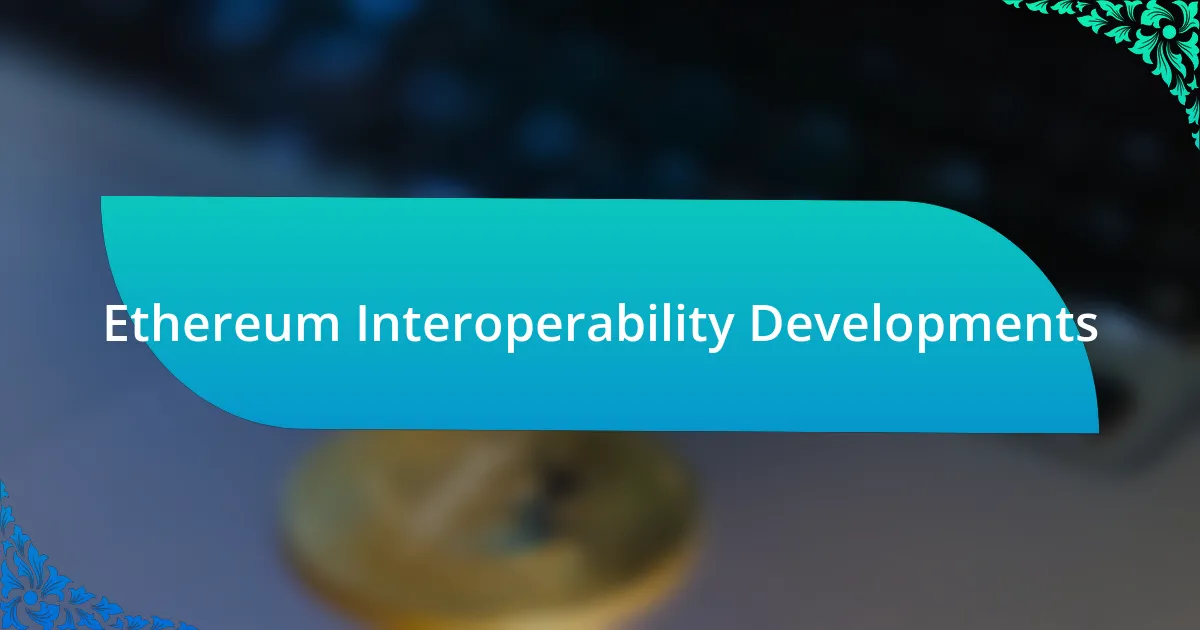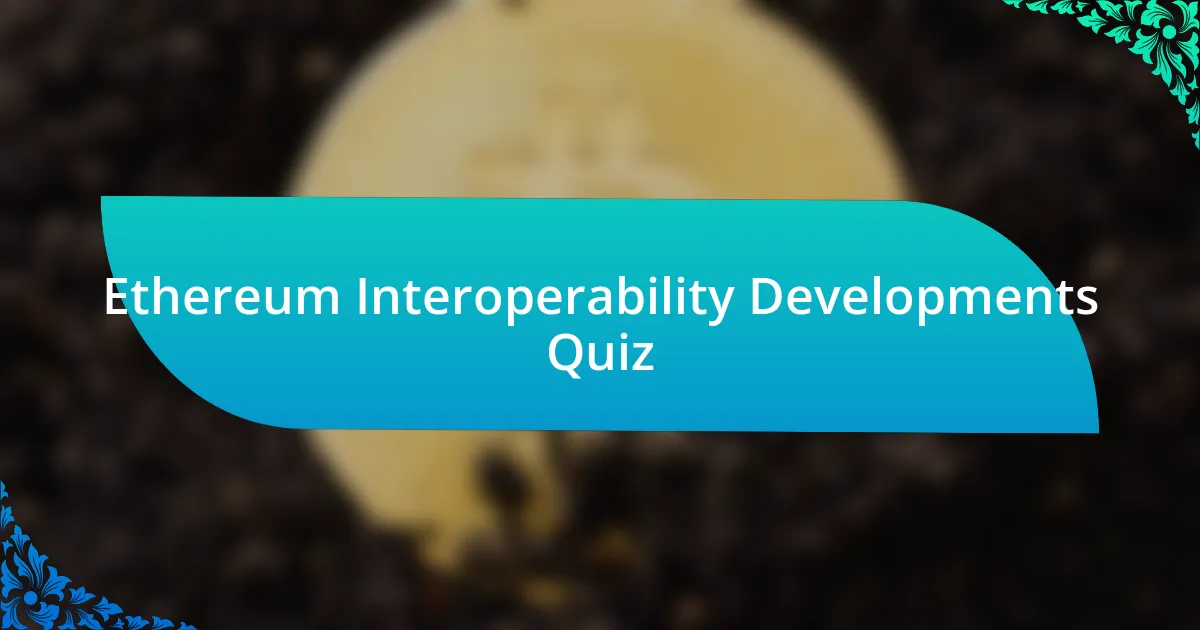
Start of Ethereum Interoperability Developments Quiz
1. What is Ethereum`s role in blockchain interoperability?
- Ethereum is one of the key drivers of blockchain interoperability, contributing to cross-chain solutions and enabling inter-chain communication.
- Ethereum serves as a primary ledger for all transactions across different blockchains.
- Ethereum restricts interoperability by maintaining its unique protocol without external integration.
- Ethereum only operates within its own network and does not participate in cross-chain activities.
2. Which two interoperability hubs are notable for integrating Ethereum?
- Solana and Avalanche
- Polkadot and Cosmos
- Cardano and Harmony
- Tezos and Algorand
3. How does Polkadot integrate Ethereum?
- Polkadot integrates Ethereum via bridges like Snowfork, allowing asset and smart contract interaction.
- Polkadot uses Ethereum’s blockchain directly for all transaction processing without any integrations.
- Polkadot connects with Ethereum through the Decentralized Autonomous Organization (DAO) model for governance.
- Polkadot integrates Ethereum by replacing Ethereum nodes with its own network validators.
4. How does Cosmos integrate Ethereum?
- Cosmos incorporates Ethereum via its own blockchain creation process.
- Cosmos uses the Lightning Network for Ethereum integration.
- Cosmos connects Ethereum using cross-chain atomic swaps.
- Cosmos integrates Ethereum through the Gravity Bridge, allowing token transfers.
5. What are ERC-20 and ERC-721 standards used for in Ethereum?
- ERC-20 and ERC-721 are storage solutions for Ethereum.
- ERC-20 and ERC-721 are security measures for Ethereum.
- ERC-20 and ERC-721 are token standards for Ethereum.
- ERC-20 and ERC-721 are mining protocols for Ethereum.
6. What is the purpose of ERC-1155 in Ethereum?
- ERC-1155 manages decentralized identity solutions.
- ERC-1155 only supports non-fungible tokens.
- ERC-1155 is used for Bitcoin transactions.
- ERC-1155 supports both fungible and non-fungible tokens.
7. What is the primary focus of sharding in Ethereum 2.0?
- Scaling
- Decentralization
- Security
- Privacy
8. What are some notable cross-chain bridges?
- Multichain
- ChainLink
- EtherSwap
- Blockchain Bridge
9. How do cross-chain bridges enable transfers?
- Cross-chain bridges facilitate transfers using decentralized exchanges like Uniswap.
- Cross-chain bridges enable transfers using only native tokens from each blockchain.
- Cross-chain bridges allow transfers through centralized exchanges like Binance.
- Cross-chain bridges enable transfers using wrapped tokens (e.g., WBTC) or liquidity pools.
10. What is the role of wrapped tokens in cross-chain bridges?
- Wrapped tokens encapsulate the value of one token in another token.
- Wrapped tokens create new blockchains for asset exchanges.
- Wrapped tokens convert fiat currencies into digital assets.
- Wrapped tokens limit the movement of tokens across chains.
11. What is the purpose of liquidity pools in cross-chain bridges?
- Liquidity pools hold inventory of various coins where one can be exchanged for another, facilitating cross-chain transfers.
- Liquidity pools provide interest for saving accounts in traditional banks.
- Liquidity pools are used to create non-fungible tokens for art sales.
- Liquidity pools are designed to store user passwords securely.
12. Which consensus algorithm does Ethereum currently use?
- Proof-of-Work (PoW)
- Delegated Proof-of-Stake (DPoS)
- Proof-of-Stake (PoS)
- Practical Byzantine Fault Tolerance (PBFT)
13. What are smart contracts in Ethereum?
- Smart contracts are simply digital wallets used for storing Ether and tokens.
- Smart contracts are like legal documents in code, providing a digital verification process or enforcing negotiations between parties.
- Smart contracts are only relevant for creating decentralized applications on Ethereum.
- Smart contracts are a type of cryptocurrency used for trading purposes on exchanges.
14. What is the Ethereum node responsible for?
- Ethereum nodes mine new tokens through complex algorithms.
- Ethereum nodes interact with each other using the Ethereum blockchain protocol and interact with the outside world using the JSON-RPC interface.
- Ethereum nodes serve as storage for all blockchain data permanently.
- Ethereum nodes create and deploy smart contracts independently.
15. What are private keys used for in Ethereum?
- Private keys are used to sign transactions.
- Private keys are used to create new coins.
- Private keys are used to monitor network activity.
- Private keys are used to generate smart contracts.
16. How does one mine ethers?
- One needs to have a wallet and tools like Geth CLI to participate in the network and help add transactions to the blocks.
- Ether can be mined using only standard personal computers without any extra tools.
- Just download mining software without any hardware requirements.
- You simply buy ethers from exchanges and store them.
17. What is MetaMask?
- MetaMask is a hardware device for secure storage of Bitcoin.
- MetaMask is a cryptocurrency exchange platform for trading various tokens.
- MetaMask is a popular browser-based Ethereum wallet used to interact with dApps on the Ethereum network.
- MetaMask is a type of Ethereum smart contract that automates transactions.
18. Which programming language is primarily used to write smart contracts and dApps in Ethereum?
- C++
- Java
- Python
- Solidity
19. What are the benefits of having a private network in Ethereum?
- Private networks restrict access to smart contracts only.
- Private networks are useful for data privacy, permissions testing, and control.
- Private networks eliminate all transaction fees on Ethereum.
- Private networks are solely used for public broadcasting of transactions.
20. What is Truffle in the context of Ethereum development?
- Truffle is a testing and development environment for Ethereum.
- Truffle is a consensus algorithm used in Ethereum.
- Truffle is a type of Ethereum token standard.
- Truffle is a decentralized exchange platform for Ethereum.
21. What is the block time and average block size in Ethereum?
- The block time is 30 seconds, and the average block size is 4 KB.
- The block time is 5 seconds, and the average block size is 3 KB.
- The block time is 14 seconds, and the average block size is 2 KB.
- The block time is 10 seconds, and the average block size is 1 KB.
22. Can transactions be kept hidden in the public Ethereum network?
- Yes, they can be fully hidden.
- No, all transactions are public.
- Yes, only large transactions can be concealed.
- Yes, using special private keys allows hiding.
23. Is the user’s private key used to sign transactions?
- No.
- Yes.
- Sometimes.
- Maybe.
24. What is the functionality of Testnet in Ethereum?
- Testnet is used to connect to the Ropsten Network.
- Testnet is used to create new cryptocurrencies without any limits.
- Testnet is used to mine real Ether efficiently.
- Testnet is used for testing smart contracts and dApps without real Ether.
25. Do you need to use real Ether to test dApps and smart contracts?
- No, free Ether can be used in test networks.
- Yes, you must use real Ether for testing.
- Yes, real Ether is needed for all dApp interactions.
- No, testing requires only Ethereum mainnet transactions.
26. How does “spending” work in smart contracts?
- Spending on smart contracts is free and requires no gas for any type of action.
- Only the deployment of smart contracts incurs a gas fee, while execution does not.
- There is no cost associated with tasks that do not modify the smart contract, but any action that modifies the contract costs gas.
- All tasks related to smart contract execution require Ether to perform any actions.
27. What is Remix in the context of Ethereum development?
- Remix is a decentralized exchange for Ethereum tokens.
- Remix is a blockchain protocol that competes with Ethereum.
- Remix is a new type of cryptocurrency invented for Ethereum.
- Remix is an online tool used to deploy, test, and develop smart contracts.
28. How does Bitcoin differ from Ethereum in checking the latest state?
- Bitcoin verifies state by interpreting smart contracts on its blockchain.
- Ethereum relies on a single transaction structure for state checks like Bitcoin.
- Ethereum checks the latest state for account balance, while Bitcoin checks unspent transaction outputs (UTXO).
- Bitcoin checks account balance using a centralized ledger approach.
29. What happens when gas runs out without the transaction being complete?
- All state changes are reversed, and the used Ethereum Gas is given to the miner.
- The gas fees are refunded to the user.
- The transaction is completed without any charges.
- The transaction is placed in a pending queue for later completion.
30. What are some ongoing initiatives to enhance cross-L2 interoperability in Ethereum?
- Cross-L2 address systems (ERC-3770), cross-L2 sends via liquidity providers (ERC-7683), and L2 light clients (ERC-3668).
- One-way bridges (ERC-4321), monolithic blockchain solutions (ERC-7654), and atomic swaps (ERC-1237).
- Single-chain routing protocols (ERC-1234), cross-L2 token locks (ERC-8765), and L2 vault contracts (ERC-5432).
- Layer-1 scaling solutions (ERC-2345), centralized exchange integrations (ERC-4567), and proxy tokens (ERC-6789).

Quiz Successfully Completed!
Congratulations on completing the quiz about Ethereum Interoperability Developments! We hope you found the experience both enjoyable and enlightening. Engaging with these questions helped reinforce key concepts surrounding how different blockchain networks can communicate and collaborate. You may have discovered new insights into the challenges and innovations driving interoperability in the Ethereum ecosystem.
Throughout the quiz, you explored important technological advancements. You learned how protocols are evolving to enhance cross-chain communication and improve the overall functionality of decentralized applications. Understanding these developments is crucial for anyone interested in the future of blockchain technology and its potential use cases.
For those eager to learn more, we invite you to check out the next section on this page. It contains valuable information on Ethereum Interoperability Developments that can broaden your understanding even further. Dive deeper into this fascinating topic and stay ahead in the rapidly changing world of blockchain!

Ethereum Interoperability Developments
Introduction to Ethereum Interoperability
Ethereum interoperability refers to the ability of the Ethereum blockchain to interact and communicate with other blockchains and networks. This capability enhances the functionality of Ethereum by allowing it to share data and assets, facilitating cross-chain transactions. Improvements in interoperability can lead to a more cohesive decentralized ecosystem, promoting liquidity and user the overall user experience. Recent developments in interoperability efforts aim to solve the inherent barriers between various blockchains and simplify the complexities of decentralized applications, creating a more inclusive environment for users and developers.
Key Protocols and Standards for Interoperability
Several protocols and standards are designed to enhance Ethereum’s interoperability. For instance, the Inter-Blockchain Communication (IBC) protocol enables blockchains to communicate securely while exchanging data and tokens. Another significant development is the Wrapped ERC-20 standard, which allows tokens from other blockchains to be utilized on Ethereum. These protocols create bridges between diverse networks, allowing smoother transactions and interactions, ultimately increasing Ethereum’s usability in a multi-chain environment.
Multi-Chain Ecosystem Initiatives
Various multi-chain initiatives are underway to bolster Ethereum’s interoperability. Projects like Polkadot and Cosmos have established ecosystems that prioritize cross-chain capabilities. They focus on connecting multiple blockchains, including Ethereum, allowing for the seamless exchange of information and value. These efforts not only enhance Ethereum’s functionality but also encourage collaboration between different blockchain networks, fostering a thriving decentralized ecosystem.
Layer 2 Solutions Supporting Interoperability
Layer 2 solutions play a crucial role in improving Ethereum’s interoperability by enhancing scalability and transaction speed. Technologies such as Rollups allow multiple transactions to be processed off-chain while ensuring security through the Ethereum mainnet. This capability allows for more efficient interactions with other blockchains. By reducing congestion and lowering costs, Layer 2 solutions encourage developers to build applications that can interact with multiple chains, enhancing the overall interoperability landscape of Ethereum.
Future of Ethereum Interoperability
The future of Ethereum interoperability looks promising with ongoing developments and innovations. As the demand for interoperable blockchains grows, Ethereum is likely to witness more robust solutions making cross-chain interactions smoother. Advances in technology, such as zero-knowledge proofs, are expected to improve privacy and security in cross-chain transactions. Furthermore, as regulatory clarity emerges, the adoption of interoperable technologies will likely accelerate, paving the way for a more integrated blockchain ecosystem.
What is Ethereum Interoperability?
Ethereum interoperability refers to the capability of the Ethereum blockchain to seamlessly interact with other blockchains and networks. This allows for the transfer of assets and data across different platforms, enhancing user experience and expanding the use cases of decentralized applications. Projects like Polkadot and Cosmos aim to facilitate such interactions by creating ecosystems where various blockchains can communicate effectively.
How is Ethereum Interoperability being developed?
Ethereum interoperability is being developed through various protocols and standardization efforts. Solutions like bridges, which link Ethereum to other blockchains, are gaining traction. For example, the Ethereum Bridge enables users to transfer ERC-20 tokens between Ethereum and the Binance Smart Chain. Additionally, Layer 2 solutions, like Optimistic Rollups, enhance scalability and facilitate cross-chain functionalities.
Where can Ethereum Interoperability be observed?
Ethereum interoperability can be observed in decentralized finance (DeFi) platforms and cross-chain decentralized applications (dApps). For instance, platforms like Aave and SushiSwap are integrating with other chains, allowing users to lend, borrow, and swap assets across different blockchain networks. Furthermore, initiatives like the Inter-Blockchain Communication (IBC) protocol provide a framework for interoperability between Ethereum and other ecosystems.
When did Ethereum Interoperability developments start gaining traction?
Ethereum interoperability developments began gaining traction around 2018, with the emergence of cross-chain protocols and projects focused on connecting various blockchains. The release of the Ethereum 2.0 beacon chain in December 2020 further emphasized the importance of interoperability as the blockchain ecosystem expanded. Since then, numerous projects and research initiatives have actively worked towards enhancing interoperability features.
Who is leading the Ethereum Interoperability developments?
Key players in Ethereum interoperability developments include organizations and projects like the Ethereum Foundation, Chainlink, Polkadot, and Cosmos. They are pioneering research and implementing technologies to bridge Ethereum with other blockchains. Additionally, various developers and contributors within the Ethereum community work on open-source solutions to enable greater interoperability.

